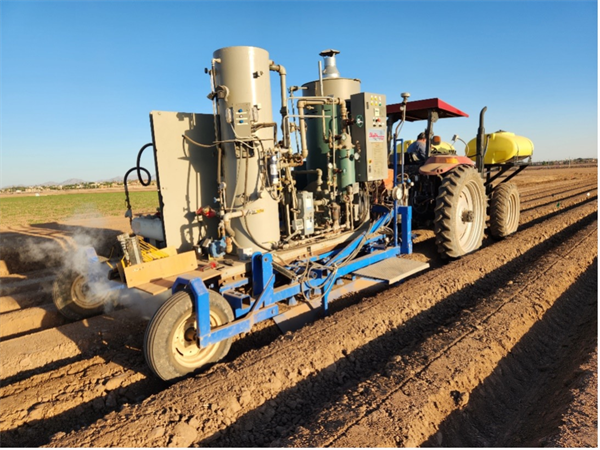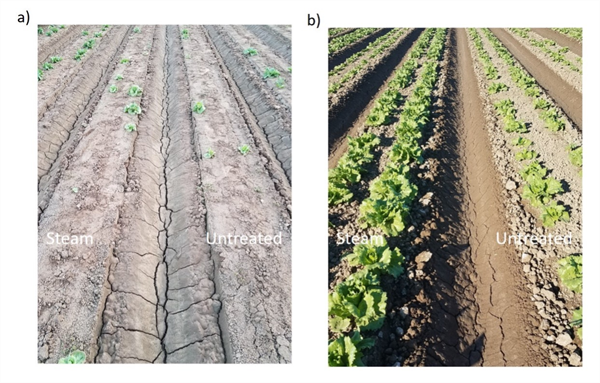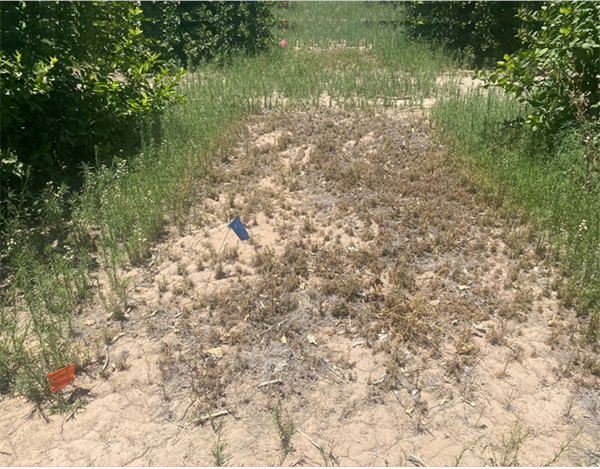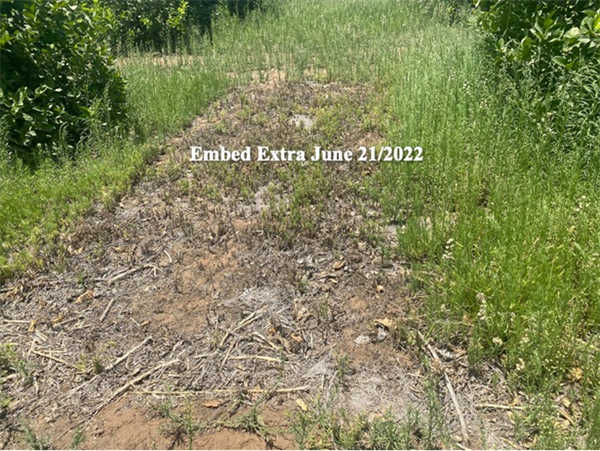



Frost and freeze damage affect countless fruit and vegetable growers leading to yield losses and occasionally the loss of the entire crop. Frost damage occurs when the temperature briefly dips below freezing (32°F).With a frost, the water within plant tissue may or may not actually freeze, depending on other conditions. A frost becomes a freeze event when ice forms within and between the cell walls of plant tissue. When this occurs, water expands and can burst cell walls. Symptoms of frost damage on vegetables include brown or blackening of plant tissues, dropping of leaves and flowers, translucent limp leaves, and cracking of the fruit. Symptoms are usually vegetable specific and vary depending on the hardiness of the crop and lowest temperature reached. A lot of times frost injury is followed by secondary infection by bacteria or opportunist fungi confusing with plant disease.
Most susceptible to frost and freezing injury: Asparagus, snap beans, Cucumbers, eggplant, lemons, lettuce, limes, okra, peppers, sweet potato
Moderately susceptible to frost and freezing injury: Broccoli, Carrots, Cauliflower, Celery, Grapefruit, Grapes, Oranges, Parsley, Radish, Spinach, Squash
Least susceptible to frost and freezing injury: Brussels sprouts, Cabbage, Dates, Kale, Kohlrabi, Parsnips, Turnips, Beets
More information:
Last week, we initiated our first trial of the season examining the use of band steam for controlling Fusarium wilt of lettuce. The premise behind this research is to use steam heat to raise soil temperatures to levels sufficient to kill soilborne pathogens. For Fusarium oxysporum f. sp. lactucae (FOL) the pathogen which causes Fusarium wilt of lettuce, the required temperature for control is generally taken to be > 140°F for 20 minutes. Soil solarization, where clear plastic is placed over the crop bed during the summer, exploits this concept. The technique raises soil surface temperatures to 150-155˚F, effectively killing the pathogen and reducing FOL disease incidence by 45-98% (Matheron and Porchas, 2010).
In our trials, we are using steam heat to raise soil temperatures. Steam is delivered by a 35 BHP steam generator mounted on a custom designed elongated bed shaper (Fig. 1). As the device travels through the field, steam is injected into the soil in narrow bands centered on the seedline. Soil temperatures are raised to about 190°F. After cooling (< ½ a day), the crop is planted into the disinfested soil.
Trials conducted in prior years show the technique holds promise; however further work is needed. In these studies, a 4” wide by 2” deep band of soil was treated. Although soil assay results showed that steam treatment significantly reduced the number of Fusarium colony forming units by over 95% as compared to the untreated control, this didn’t always translate into reductions in disease incidence. At one field site with a known history of FOL, band-steam provided no benefit with virtually all lettuce plants succumbing to the disease (Fig 2a). However, at another site, disease incidence was reduced by more than 40%, plants appeared to be healthier and more vigorous, and yield was increased by more than 90% (Fig. 2b). One explanation for this difference is that at the first site, Fusarium inoculum loads were very high and the width and/or depth of soil treated by steam wasn’t large enough to protect seedling roots, which are highly susceptible to FOL, from infection. The aim of this year’s trial is to determine the width and depth of soil that needs to be disinfested to prevent disease. In the current study, we are examining bands of soil receiving steam treatment that range in size from 4” wide by 2” deep to 6” wide by 4” deep.
Stay tuned for final trial results and reports of our other studies examining the efficacy of using steam heat to control sclerotinia lettuce drop, pythium and weeds.
As always, if you are interested in trying band-steam on your farm or would like more information, please feel free to contact me.
References
Matheron, M. E., & Porchas, M. 2010. Evaluation of soil solarization and flooding as management tools for Fusarium wilt of lettuce. Plant Dis. 94:1323-1328.
Acknowledgements
This project is sponsored by USDA-NIFA, the Arizona Specialty Crop Block Grant Program and the Arizona Iceberg Lettuce Research Council. We greatly appreciate their support.
A special thank you is extended to Fatima Corona, Roberto Delgado, Chad VanMatre, Matt McGuire and JV Farms for their generous assistance and allowing us to conduct this research on their farm.

Fig. 1. Band-steam applicator principally comprising a 35 BHP steam generator
mounted on a bed-shaper applicator sled. The device injects steam into the soil
as beds are formed.

Fig. 2. Lettuce seedlings at field sites with (a) very high and (b)
moderate levels of Fusarium wilt of lettuce inoculum. Band-steam
(left) and untreated (right) plots are shown.
Surveying the Yuma area, we have observed a lot of Hairy Fleabane (Conyza bonariensis) and received calls from PCA's regarding this weed and its control.
We have observed that the application of Glyphosate is not showing good efficacy in controlling this species in parts of Yuma and Phoenix area.
Resistance to glyphosate has been reported in some grain growing areas of Queensland and northern New South Wales and other cropping regions across Australia (1) as well as Spain (2).
Other cases of resistance to other herbicides such as paraquat, and 2,4-D have been confirmed (3).
In the International Herbicide Resistance Weed Database it is reported that in Switzerland that both Conyza canadiensis (Horseweed) and Conyza bonariensis (Hairy Fleabane) presented resistance to a HRAC Group 9 herbicide last year. We found resistance reported in California only and not in Arizona (4).
Some of our PCA amigos and field technicians have reported having problems finding a good treatment for fleabane due to possible glyphosate resistance. We included Glufosinate and Embed Extra in a trial last year. The images below show good results of an application of Rely at a high rate (82floz) with two applications at a 2-week interval. The second picture shows the efficacy of Embed Extra (2 pt.) following the same application schedule. Weeds were ~2-3” at the time of application. Some growers have reported good results with glufosinate in Waddell AZ. Sharpen has also been used by Yuma citrus growers.
A study showed that plants grown at 90% relative humidity presented more translocation of glufosinate than those grown at 35%. Relative humidity had greater effect than temperature on glufosinate toxicity to Palmer amaranth, redroot pigweed, and common waterhemp (5). In a trial conducted by Barry Tickes from UA nutsedge control was better in an August application with a ~40% RH than a June application with ~20% RH.
As always please check labels and registration before using these treatments.

Figure 1. Hairy fleabane control with Glufosinate

Figure 2. Hairy Fleabane control with Embed Extra
References:
1. https://bnrc.springeropen.com/articles/10.1186/s42269-020-00316-w
2. https://cdnsciencepub.com/doi/10.1139/cjps-2018-0254
3. https://bioone.org/journals/weed-technology/volume-35/issue-4/wet.2021.11/Cross-resistance-to-diquat-in-glyphosate-paraquat-resistant-hairy-fleabane/10.1017/wet.2021.11.short
4. https://www.weedscience.org/Pages/Species.aspx
5. Coetzer, E., Al-Khatib, K., & Loughin, T. (2001). Glufosinate efficacy, absorption, and translocation in amaranth as affected by relative humidity and temperature. Weed Science, 49(1), 8-13. doi:10.1614/0043-1745(2001)049[0008:GEAATI]2.0.CO;2
Results of pheromone and sticky trap catches can be viewed here.
Corn earworm: CEW moth counts remain at low levels in all areas, well below average for this time of year.
Beet armyworm: Trap increased areawide; above average compared to previous years.
Cabbage looper: Cabbage looper counts decreased in all areas; below average for this time of season.
Diamondback moth: DBM moth counts decreased in most areas. About average for this time of the year.
Whitefly: Adult movement beginning at low levels, average for early spring.
Thrips: Thrips adult counts reached their peak for the season. Above average compared with previous years.
Aphids: Aphid movement decreased in all areas; below average for late-March.
Leafminers: Adults remain low in most locations, below average for March.